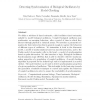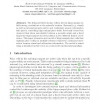246 search results - page 17 / 50 » Robot control with biological cells |
GECCO
2007
Springer
13 years 11 months ago
2007
Springer
A primary goal of evolutionary robotics is to create systems that are as robust and adaptive as the human body. Moving toward this goal often involves training control systems tha...
ICES
2010
Springer
13 years 5 months ago
2010
Springer
Abstract. In an application where autonomous robots can amalgamate spontaneously into arbitrary organisms, the individual robots cannot know a priori at which location in an organi...
TCS
2010
13 years 5 months ago
2010
We define a subclass of timed automata, called oscillator timed automata, suitable to model biological oscillators. Coupled biological oscillators may synchronise, as emerging be...
RAS
2000
13 years 7 months ago
2000
Cerebellar models have long been advocated as viable models for robot dynamics control. Building on an increasing insight in and knowledge of the biological cerebellum, many model...
ICANN
2005
Springer
14 years 27 days ago
2005
Springer
Abstract. The firing activities of place cells in the rat hippocampus exhibit strong correlations to the animal’s location. External (e.g. visual) as well as internal (proprioce...


